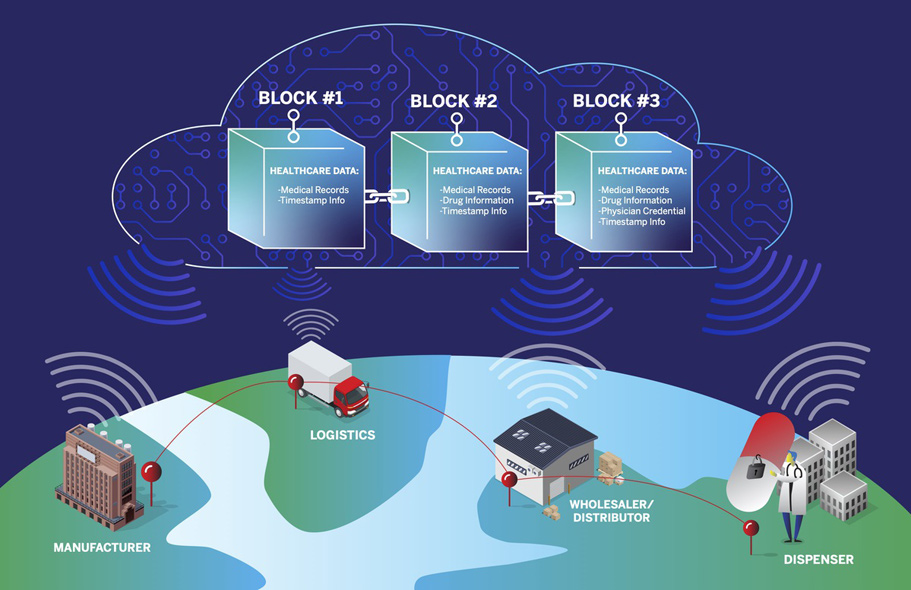- Home
- / Insights
- / FTI Journal
- / Blockchain Doctor Ordered
Is Blockchain Just What the Doctor Ordered?

-
December 08, 2020
-
The application of blockchain across various healthcare sectors could advance the industry as a whole. Here’s why.
The healthcare industry has always operated on the cutting edge of technology. From data analytics to advanced surgical robotics, medical professionals have consistently leveraged innovation to improve patient outcomes.
While that progress has generally centered on procedures, tools and medicines, one digital technology has the potential to completely transform the way healthcare information and data are governed. We’re talking of course about blockchain.
Blockchain could be just what the doctor ordered for an industry where record keeping is a lifeblood and privacy is paramount. Highly secure, visible and transparent, blockchain is essentially a digital ledger of information that is distributed efficiently across a peer network in a verifiable and permanent way. It is immutable and resistant to modification. (See graphic below.)
With those qualities, it’s no surprise that blockchain is booming across multiple industries, like banking, accounting and transportation. Between 2020 and 2025, blockchain’s market share is expected to grow at a rate of 67.3 percent (CAGR) to reach $39.7 billion.
Many healthcare companies are increasingly turning to blockchain to gain a competitive edge and as a means for reliable information exchange. In fact, recent surveys found that healthcare is one of the leading industries experimenting with blockchain. What’s more, organizations state that cost and technology do not pose a hurdle to entry.
And yet, across healthcare many sectors are resistant to greater adoption. What’s holding the industry back? What’s holding your company back?
We’re Only Humans
For all its proven value, blockchain is so innovative it may be running a step ahead of the healthcare industry in general. Implementing blockchain requires tighter processes around sharing information. That means all parties within a supply chain need access to shared data and must trust one another. Without that trust, collaboration is near impossible.
Another issue is outdated legacy systems. Blockchain is creating new operational models that leverage new capabilities. Companies need to have the technological infrastructure to hold up these processes, calling for a significant investment in revamping their systems. Quite naturally, this can be costly and deter adoption.
There is light at the end of the tunnel, however. During pilot programs, some drug manufacturers and wholesalers indicated they saw no disadvantages to collaborating. They are in fact working together to enhance their supply chain capabilities and are finding ways to implement blockchain.
Blockchain is a growing list of records, called "blocks," that are linked through a secure form of communication called cryptography. Each block contains a cryptographic "hash" (data + information) of the previous block, a timestamp, and transaction data. To maximize the efficiences of blockchain, all parties in a supply chain need access to partner data/information. This requires trust and collaboration — something that various sectors in the healthcare industry are still working through.
Breaking Down Resistance
As pilot programs and other applications of blockchain make incremental inroads in healthcare, wider resistance could fall to the wayside and we may see greater adoption. Here are two high-profile sectors where success might pave the way.
Clinical Trial Manipulation
Drug manufacturers must obtain FDA approval before marketing any new drug. This means manufacturers need to conduct extensive preclinical and clinical testing and analysis to ensure the safety and efficacy of their drug. That leads to a wealth of data — all of which needs to be verified. In the past, pharmaceutical companies have made false statements or omitted data to secure approval. With blockchain, the FDA could ensure all the information provided is accurate and confirm the safety, efficacy, pharmacology and toxicology of the new drug.
Counterfeit Medicines
According to the Kaiser Family Foundation, 29 percent of Americans have reported problems paying medical bills, which leads to their neglecting to seek further treatment. Further, it leads to patients seeking cheaper alternative medications that could, in fact, be counterfeit — and potentially lethal. Blockchain can enable visibility into the drug’s composition and ensure that patients are receiving the right care. By simply scanning a QR code, patients would be able to validate the medicine’s origin, ingredients, dosage amounts, etc. and eliminate the risk altogether.
Getting on the Blockchain Bandwagon
There is no one-size-fits-all approach when adopting a new technology. Companies must perform their own due diligence to understand if blockchain is the right solution for their organization. Like any good practice of decision-making, consider developing a pros and cons list.
Also, identify as many possible use cases of blockchain as you can — the possibilities can apply to pure supply chain logistics, like peer-to-peer processes, and also to several clinical areas where a significant number of touchpoints and data are exchanged.
There are a number of factors to consider: governance, integration, infrastructure, new entrants and other interconnected points throughout your enterprise or your supply chain partner's enterprise. Think of this exercise as an excellent way to enable buy-in and collaboration within your network by bringing your supply chain partners into this process up front.
It’s also advisable to advocate for blockchain outside of direct ROI. Pointing to the risks that blockchain mitigates might be more appealing. Should a drug recall occur, for example, would your company want to be without a technology that could help protect its reputation, people and bottom line?
Like any transformation, blockchain can disrupt and change your organization. In the end, however, its benefits will be long-lasting. As the inroads continue to open up and adoption becomes more appealing — imperative, you might say — it’s better to be near the front of the line than bringing up the rear.
© Copyright 2020. The views expressed herein are those of the authors and do not necessarily represent the views of FTI Consulting, Inc. or its other professionals.
About The Journal
The FTI Journal publication offers deep and engaging insights to contextualize the issues that matter, and explores topics that will impact the risks your business faces and its reputation.
Related Insights
Related Information
Published
December 08, 2020



